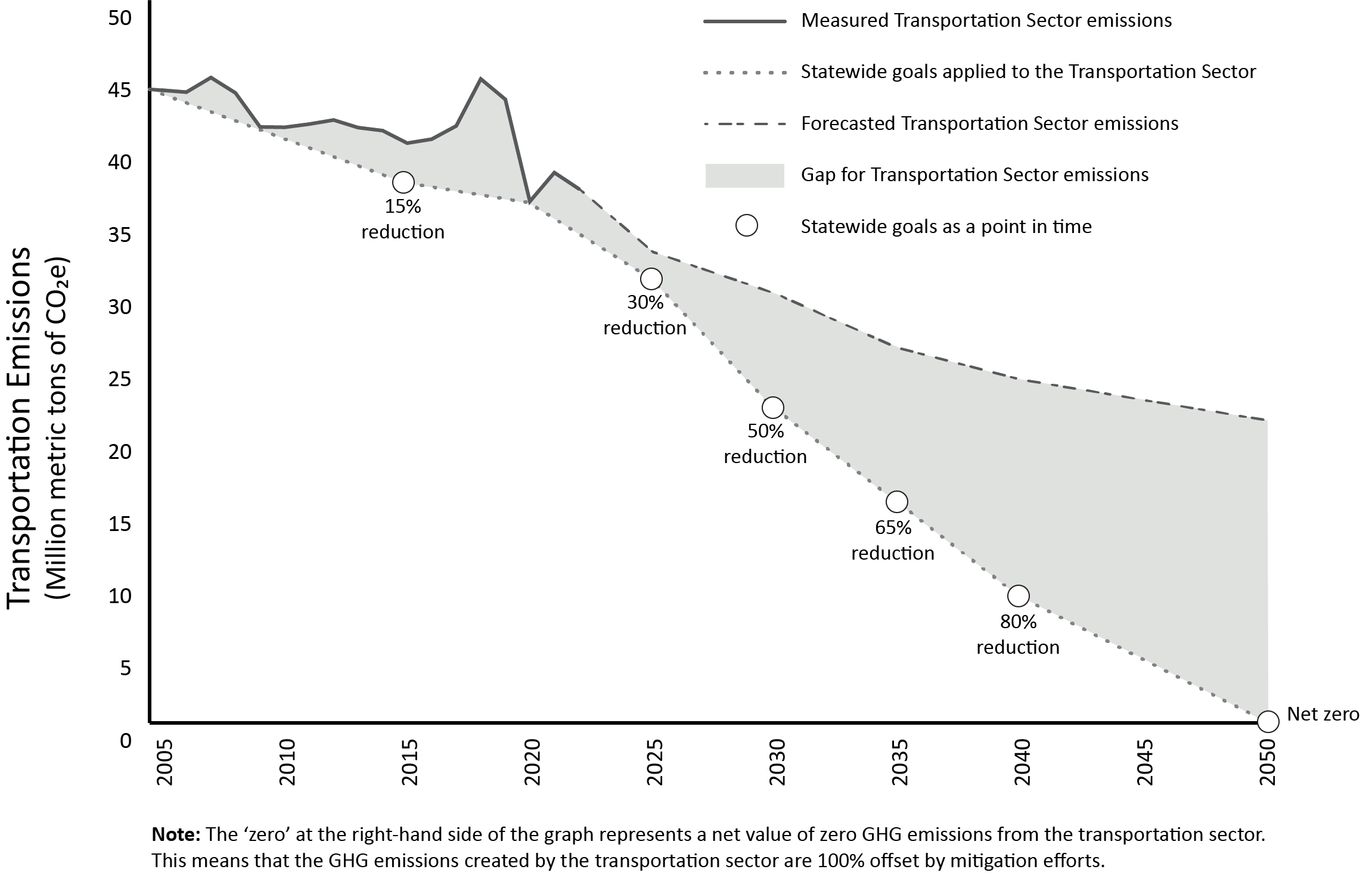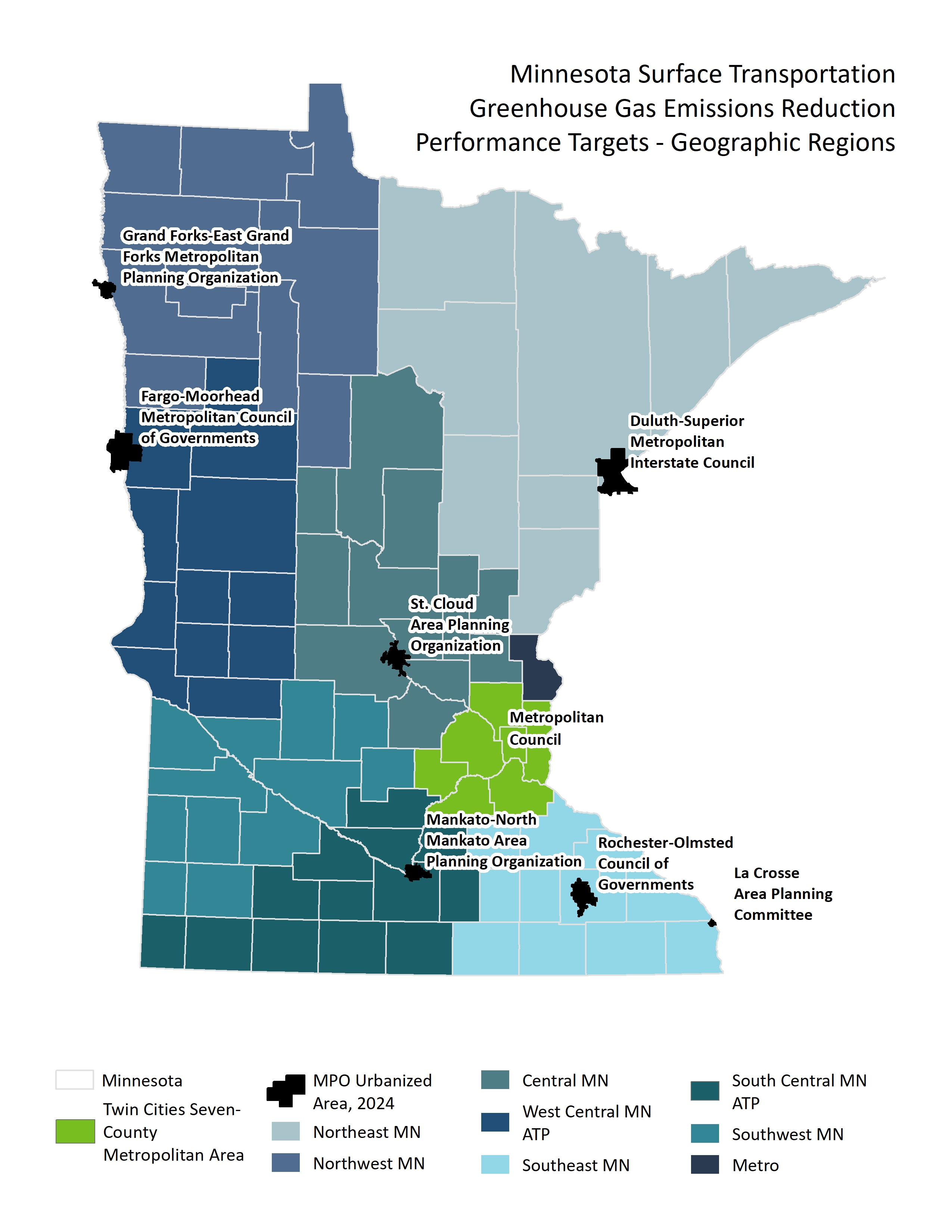Home | Reducing carbon pollution from transportation | Transportation GHG emissions legislation | Office Hours
Minnesota Greenhouse Gas Reduction Legislation: Target Setting
Background
The Minnesota Legislature passed a series of updates to state statute in 2023 and 2024 to reduce greenhouse gas (GHG) emissions. These changes include the update of the goals to reach net zero GHG emissions by 2050 from 2005 levels in Statute 216.H.02 and requires the Commissioner of Transportation to set emission reduction targets specifically for the transportation sector in Statute 174.01 subd. 3.

Target setting criteria
The law directs the Commissioner of Transportation to establish performance targets for the statewide greenhouse gas emissions reduction goal under section 216H.02 Feb. 1, 2025.
The targets must include:
- establishment of proportional emissions reduction performance targets for the transportation sector;
- specification of the performance targets on a five-year or more frequent basis; and
- allocation across the transportation sector, which:
- must provide for an allocation to the metropolitan area, as defined in section 473.121, subd. 2
- must account for differences in the feasibility and extent of emissions reductions across forms of land use and across regions of the state
- may include performance targets based on Department of Transportation district, geographic region, a per capita calculation, or transportation mode, or a combination
Target setting process
In response to the legislative requirements, MnDOT staff have worked to develop a scope of work, engage with partners internally and externally, choose an approach to evaluating the feasibility of various approaches, gather input and feedback from partners and draft recommended targets. There have been 33 engagements with external partners and 22 engagements with internal partners since April 2024.

Greenhouse gas emissions reduction performance targets established
On Monday, December 23, 2024, the Commissioner of Transportation, in accordance with Minnesota Statute 174.01 subd. 3, approved the establishment of greenhouse gas (GHG) emissions reduction performance targets for the Transportation Sector in Minnesota. The Transportation Sector is broken down into 17 sub-allocations: 16 geographic regions are assigned surface transportation emissions reduction sub-allocations based on per capita, and non-surface transportation emissions are assigned to 1 statewide sub-allocation.
A memo regarding the Minnesota Greenhouse Gas Emissions Reduction Sub-allocation Performance Targets was emailed, then mailed, to Minnesota Metropolitan Planning Organizations and Minnesota Area Transportation Partnerships on Tuesday, Jan. 14, 2025. The memo includes guidance for GHG emissions reduction sub-allocation performance targets; 2025 GHG emissions reduction sub-allocation performance targets; and next steps.
Three attachments were included with the memo:
- Attachment 1: Minnesota Greenhouse Gas Emissions Reduction Informational Sheet
- Attachment 2: Surface Transportation emissions reduction performance targets and annual benchmarks
- Attachment 3: Non-surface Transportation emissions reduction performance targets and annual benchmarks
Transportation Sector emissions
Minnesota’s Transportation Sector emissions include 12 sources. Each source can be assigned to surface transportation or non-surface transportation. Approaching these two subsector areas will be done differently. Surface transportation emissions can be allocated regionally, while Non-surface Transportation emissions are better suited to be allocated statewide and coordinated with our industry partners.
Surface Transportation emissions
Surface Transportation emissions include:
- Buses
- Medium-duty and heavy-duty trucks
- Light-duty trucks
- Motorcycles
- Passenger cars
- Recreational vehicles (RVs)
- Air conditioning emissions from on-road vehicles
- Off-highway vehicles (e.g., snowmobiles, alternative terrain vehicles, military vehicles)
Surface Transportation emissions are allocated based on 16 geographic regions of the states to provide more opportunities for accountability and context-sensitive strategies to reduce emissions.
- Seven-county Metropolitan Area
- St. Cloud Area Planning Organization’s urban area
- Duluth Metropolitan Interstate Council’s urban area
- Mankato-North Mankato Area Planning Organization’s urban area
- La Crosse Area Planning Committee’s urban area
- Rochester-Olmsted Council of Governments’ urban area
- Grand Forks-East Grand Forks MPO’s urban area
- Fargo-Moorhead Metropolitan Council of Governments’ urban area
- Northwest Area Transportation Partnership’s (ATP-1) rural area
- Northeast Area Transportation Partnership’s (ATP-2) rural area
- Central Area Transportation Partnership’s (ATP-3) rural area
- West Central Area Transportation Partnership’s (ATP-4) rural area
- Metropolitan Area Transportation Partnership’s (Metro ATP) rural area
- Southeast Area Transportation Partnership’s (ATP-6) rural area
- South Central Area Transportation Partnership’s (ATP-7) rural area
- Southwest Area Transportation Partnership’s (ATP-8)

Surface Transportation emissions reduction performance targets are assigned based on a per capita calculation of emissions per region. Each region’s five-year performance target is calculated as a cumulative sum of the previous five years’ annual benchmarks. Information about each specific region’s performance targets and annual benchmarks can be found in Memo Attachment 2.
Non-surface Transportation emissions
Non-surface Transportation emissions include:
- Aviation
- Marine (e.g., ports, waterways)
- Natural gas transmission (e.g., off-gassing of natural gas pipelines for maintenance purposes)
- Railroad
Non-surface Transportation emissions are allocated statewide as one suballocation.
On going coordination with private partners in aviation, railroads, marine (e.g., ports and waterways) and natural gas transmission is key to achieving the cumulative sum five-year performance targets and closing the gap to achieve the goal of net zero emission in 2050 from 2005 levels. Information about the Non-surface Transportation emissions reduction performance targets and annual benchmarks can be found in Memo Attachment 3.
Opportunities to learn more
Now that Transportation Sector emissions reduction performance targets have been established, MnDOT is continuing to engage with transportation partners around the state to ensure they are aware of the new greenhouse gas emissions reduction performance targets and to coordinate the next steps towards implementing reduction strategies and policies.
